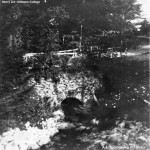Field Blog Journal 8
Jon Levinsohn
To examine the history of my site, I visited the Williams College Archives, and the house of natural history. At the college archives, the amount of information was sparse. An aerial photograph of the area in 1953 revealed that the area was mostly open, with only a handful of maple trees, which possibly may still exist as the large Norway maple that currently occupy the site, though the photograph does not present enough detail to determine if they are Norway maple, let alone estimate their age. The relative lack of trees and shrubs makes sense given the large amounts of honeysuckle, and sumac that currently occupy the area, which are earlier successional species. The lack of many species later in the successional pattern, though some small sugar maples are on the site, mostly situated very near to the river, also makes sense given these data. Given that the Norway maples are ornamentals, it is likely that they were planted, though there was no data as to when or who planted these trees.
The book, Williamstown: The First 250 Years, revealed that the oldest graves in the cemetery date back to 1820, before the cemetery was established, and it is speculated that the bodies were moved from Westlawn Cemetery on the other side of town. The cemetery was established in 1842, by a gift from Asahel Ford, however it did not yet include my sight. Later gifts expanded the cemetery to its current size, in 1887, which was purchased from the Ford family, in 1926 a gift from the Bosford’s, in 1932 a purchase from the Jones’ and the Fred Emore gift in 1932. The Emore gift was the section was said to be the section along the Green River, though several maps reveal this to not be the case. My site was on the Jones’ land, which was the largest addition to the cemetery.
A stone fence near the entrance was built in 1899, and in 1917 all buildings near the cemetery were supposedly removed. Both of these events did not occur on my site, however, as they predate the acquisition of the section of the cemetery that I studied. The various maps from the era show how varying paths of the river, especially the width and possible pond (according to the 1876 map) near my sight along with the varying amounts of winding immediately up stream. It is difficult to determine whether this is a real change over time, or due to inaccuracies in the older maps. It would not be surprising that the river would change over a couple of hundred years given the relative speed. Furthermore, the river appears to have eroded a deeper channel since the 1953 photo.  Since the property did not belong to the college, the archives provided little more information.
The house of local history had lost the majority of the data that they had on the cemetery, aside from who was buried where. However they did have maps. The land belonged to lot 297 in the original town planning, though no data on who owned the land was provided. In 1856, the Cole‚Äôs bought the land, along with a large amount of the land around, and moved to the lot from Main Street. H.T. Cole built a general store off of Water Street on the property, which burned down in 1874, and was re-built. The land itself, was used in a manner similar much of the surrounding land at the time. The H.T. Cole had a ‚Äúsloping‚ÄĚ orchard, a garden along with livestock. At this point the land was cleared of any forest had any remained though the unknown previous owners actions. When H.T. Cole aged, Charles S. Cole, H.T.‚Äôs only son and Treasurer of Williams College, took charge of the land, and bought the neighboring Walley Family‚Äôs land (which had the Walley Bridge, possibly explaining the stone ruins east of my site near the river) before 1873. Here the information concerning the site‚Äôs use and ownership disappears. I intended to pursue this further should the House of Local history find the missing binder.
As to usage of the land before Williamstown was settled, it is certainly possible that Native Americans could have had dramatic impacts upon the land, such as clearing it for growing corn. However, there is no evidence of any Native American activity in the area.









 This is a drawing that appeared in Durfee’s Biographical Annals in 1871. As can be seen, the surrounding area is for the most part empty of trees. Keep in mind, however, that this is an artist’s interpretation of the site, and that the monument is actually much smaller than it is portrayed here.
This is a drawing that appeared in Durfee’s Biographical Annals in 1871. As can be seen, the surrounding area is for the most part empty of trees. Keep in mind, however, that this is an artist’s interpretation of the site, and that the monument is actually much smaller than it is portrayed here. Sage and WIlliams Annexes are the two houses below Williams and Sage Halls where Mission Dormitory now stands. My site (between the annexes and the halls) seems similarly forested then to how it is now.
Sage and WIlliams Annexes are the two houses below Williams and Sage Halls where Mission Dormitory now stands. My site (between the annexes and the halls) seems similarly forested then to how it is now.